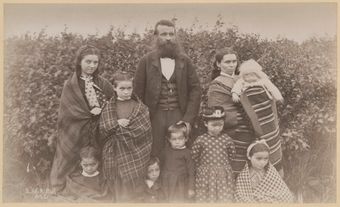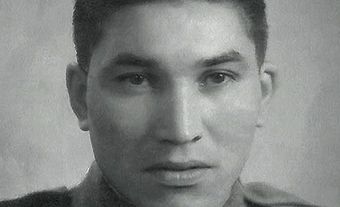Early Life and Education
Peter Tomkins Jr. was born on Poundmaker Reserve in Saskatchewan to Peter Tomkins Sr. (1865–1941) and his Cree wife, Marie Essawakapiw (“Dent in the Grass Woman”). During the 1885 North-West Rebellion, Louis Riel imprisoned Tomkins Sr., who worked as a telegraph line cutter, for repairing telegraph lines cut by the Métis. But he remained sympathetic to Riel and the Métis cause and influenced his son with stories about events like the 1885 resistance at Batoche (see The Battle of Batoche and the North-West Rebellion).
Tomkins Sr. worked as an Indian Department (see Federal Departments of Indigenous and Northern Affairs) farm instructor and land agent in the Grande Prairie area from 1907 to 1911 and helped build the first hospital in Grouard, Alberta. His wife had been the youngest wife of Pitikwahanapiwiyin (Poundmaker). Both parents reinforced the importance of learning Cree to their children and Tomkins Jr. spoke it fluently. In fact, some sources indicate that Tomkins spoke mostly Cree as a young boy.
Tomkins Jr. grew up on reserves such as Saddle Lake, Sweetgrass and One Arrow, where his father worked. He was educated in Winnipeg, Manitoba.
Personal Life
Returning to Grouard, Alberta, Peter Tomkins opened a blacksmith shop. He married Isabella Andrews, a Métis from the Grouard area. They had 10 children and three stepchildren.
Political Activism
During the 1930s, Peter Tomkins often met with Métis leader, organizer and teacher Joe Dion to discuss the living conditions of Alberta’s Métis. An excellent diplomat, organizer and negotiator, Tomkins developed a friendship with Malcolm Norris, Jim Brady, and Felix Callihoo, Métis leaders and activists. An effective health care lobbyist, Tomkins helped many in Grouard’s Métis community by convincing doctors to visit them.
Tomkins, along with Felix Callihoo, Jim Brady, Dion and Norris, founded L’Association des Métis d’Alberta et les Territories du Nord-Ouest in 1932 (now the Métis Nation of Alberta). They aimed to protect land rights for Métis in Alberta and improve their socio-economic condition.
After this group’s intense lobbying, the provincial government created the Ewing Commission to investigate the living conditions of Alberta’s Métis. As negotiators, Tomkins, Brady and Norris reinforced that the Métis held inherent rights to land, resources, education and health care. During this time, Tomkins also liaised with Dr. Wallace Cross, Alberta’s minister of health, to try and launch government studies of Métis health concerns.
The commission’s final report, produced in 1936, resulted in Alberta passing, two years later, the Metis Population Betterment Act. Because of his diplomatic skills, Tomkins was selected to help draft this first Métis-specific legislation in Canada. It gave Alberta’s Métis welfare programs and tracts of land, resulting in the formation of 12 Métis “colonies” or settlements by orders-in-council between 1938 and 1941.

The First Métis Association of Alberta (MAA) Executive. Back Row L-R: Peter Tomkins (vice-president), Felix Callihoo (vice-president); Front Row L-R: Malcom Norris (vice-president), Joseph Dion (president), James Brady (secretary-treasurer). Courtesy Glenbow Archives PA-2218-109.
Role in Métis Settlements
Peter Tomkins became supervisor of the Métis settlements (along with Joe Dion) before the outbreak of the Second World War in 1939; he held high expectations for them. Travelling to the settlements, he asked residents what locations they wanted and ensured that the Métis, not government, chose the sites. Both Peter and his brother signed over their lands to the Elizabeth Métis Settlement, but he never lived there.
After a short time, a new, non-Métis supervisor was hired to replace Tomkins. Since all five of his sons had joined the army, their absence made a significant economic impact on the family. At the same time, Jim Brady and Malcolm Norris had enlisted in the military, which left Tomkins as the sole Métis Association co-founder left in Alberta.
After the war, the government oversaw the daily affairs and management of the settlements with little input from the Métis. An affirmed socialist, Tomkins found it challenging to organize his people and drifted away from Métis politics.
DID YOU KNOW?
Tomkins’ son Charles (Checker) Tomkins, born in Grouard, Alberta in 1918, was a secret code talker (see Cree Code Talkers) in the Second World War. Assigned to the US 8th Air Force and the 9th Bomber Command in England, he translated secret military messages from English into Cree to disguise the content from enemies. He and other code talkers are credited with having helped the Allies win the war. He is the subject of a 2016 short documentary, Cree Code Talker
CCF Involvement
Disappointed with the settlements and the stagnation of the Métis Association, Peter Tomkins chose a new organizational focus: the marketing of fish and fur and the cooperative movements in Northern Alberta and Saskatchewan. He believed that to stop the exploitation of Indigenous people, it was necessary to break the Hudson’s Bay Company monopoly.
Malcom Norris and Jim Brady arranged for Tomkins to go to Saskatchewan in 1950 as a special field officer for the Co-operative Commonwealth Federation (CCF) government (later the NDP). He set up cooperatives and government stores in northern communities such as Cumberland House and La Ronge. During this time, he also provided Cree radio programs in Northern Saskatchewan for the Canadian Broadcasting Corporation.
Death and Legacy
Allan Quandt, an active CCF member and friend of Malcolm Norris and Jim Brady, said of Tomkins: “You’ll never get a better organizer… He was a great PR man… he could charm the pictures off the wall and he had a great repertoire of stories.”
Tomkins’ leadership, lobbying and organizing efforts enhanced the health and daily living conditions of the Métis in Alberta and Saskatchewan.
The Alberta Métis Historical Society has identified Peter Tomkins Jr. as one of six heroes among the province’s Métis, alongside Gabriel Dumont, Louis Riel, Jim Brady, Malcolm Norris, and Joseph Dion.
After suffering three strokes, Tomkins died in June 1970 in the hospital at High Prairie, Alberta. He is buried in the cemetery that was part of the St. Bruno Mission, a residential school in Joussard, Alberta.

 Share on Facebook
Share on Facebook Share on X
Share on X Share by Email
Share by Email Share on Google Classroom
Share on Google Classroom







